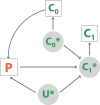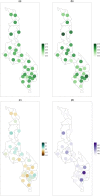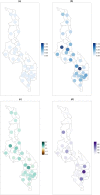Hierarchical Statistical Models to Represent and Visualize Survey Evidence for Program Evaluation: iCCM in Malawi
- PMID: 28036399
- PMCID: PMC5201252
- DOI: 10.1371/journal.pone.0168778
Hierarchical Statistical Models to Represent and Visualize Survey Evidence for Program Evaluation: iCCM in Malawi
Abstract
Policy and Program evaluation for maternal, newborn and child health is becoming increasingly complex due to changing contexts. Monitoring and evaluation efforts in this area can take advantage of large nationally representative household surveys such as DHS or MICS that are increasing in size and frequency, however, this analysis presents challenges on several fronts. We propose an approach with hierarchical models for cross-sectional survey data to describe evidence relating to program evaluation, and apply this approach to the recent scale up of iCCM in Malawi. We describe careseeking for children sick with diarrhea, pneumonia, or malaria with empirical Bayes estimates for each district of Malawi at two time points, both for careseeking from any source, and for careseeking only from health surveillance assistants (HSA). We do not find evidence that children in areas with more HSA trained in iCCM are more likely to seek care for pneumonia, diarrhea, or malaria, despite evidence that many indeed are seeking care from HSA. Children in areas with more HSA trained in iCCM are more likely to seek care from a HSA, with 100 additional trained health workers in a district corresponding to a 2% average increase in careseeking from HSA. The hierarchical models presented here provide a flexible set of methods that describe the primary evidence for evaluating iCCM in Malawi and which could be extended to formal causal analyses, and to analysis for other similar evaluations with national survey data.
Conflict of interest statement
The authors have declared that no competing interests exist.
Figures



References
-
- Liu L, Oza S, Hogan D, et al.. Global, regional, and national causes of child mortality in 2000–13, with projections to inform post-2015 priorities: an updated systematic analysis. The Lancet 2015; 385(9966):430–440. - PubMed
-
- Hsu J, Pitt C, Greco G, Berman P, Mills A. Countdown to 2015: changes in official development assistance to maternal, newborn, and child health in 2009–10, and assessment of progress since 2003. The Lancet. 2012. October 5;380(9848):1157–68. - PubMed
-
- World Health Organization, UNICEF, eds. Joint statement on integrated community case management of childhood illness: An equity-focused strategy to improve access to essential treatment services for children Geneva: World Health Organization, 2012. http://www.who.int/maternal_child_adolescent/documents/iccm_service_acce... (accessed Nov 2, 2014). - PubMed
-
- Chopra M, Sharkey A, Dalmiya N, et al. Strategies to improve health coverage and narrow the equity gap in child survival, health, and nutrition. The Lancet 2012; 380(9850):1331–1340. - PubMed
-
- Marsh DR, Hamer DH, Pagnoni F, et al. Introduction to a special supplement: Ev- idence for the implementation, effects, and impact of the integrated community case management strategy to treat childhood infection. The American Journal of Tropical Medicine and Hygiene 2012; 87(5 Suppl):2–5. 10.4269/ajtmh.2012.12-0504 - DOI - PMC - PubMed
MeSH terms
LinkOut - more resources
Full Text Sources
Other Literature Sources
Medical

